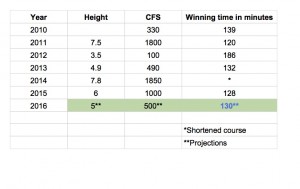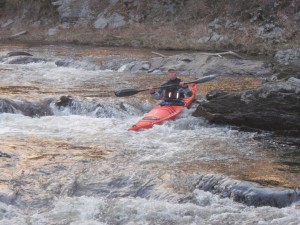Heraclitus tells us that we cannot step twice into the same river. As far as I know, Heraclitus wasn’t a paddler, but he probably would have agreed that you can’t paddle the same river twice either.
Those who raced along the Kenduskeag Stream for 16.5 miles between Kenduskeag and Bangor yesterday found a river very different from the race day river of recent years. One paddler said it was the lowest level he remembers on race day for the last dozen years or so. Pretty ironic to have such low spring river levels following a winter in which we had so much snow. A Bangor area total of 0.00 inches of rain during the 10 days prior to the race pretty much explains it.
A low river level meant the Kenduskeag Stream was full of rocks of all shapes and sizes, many of them mean and pointy looking, that few of us had seen before. It meant that the current, which gives as much as a 2 mph boost to paddlers some years, was non-existent. It meant that even when you could maneuver around the rocks, you could frequently feel your boat speed drop as the hull bogged down in the shallow water.
By my calculations, the Kenduskeag “felt” about 4 miles longer than it did two years ago, in a year of high water. The bottom line is that it’s difficult or impossible to meaningfully compare times from year to year.
But “times” isn’t what it is all about, anyway. It’s about time — having a good time on the river. It’s about the celebration of spring, the awakening landscape, and the melting of all that snow. Although I train for the race, have a specialized kayak, and possibly take it more seriously than most, one of the things I look forward to most about the Kenduskeag is the beauty of the spring river as it unfolds toward Bangor. I look forward to the camaraderie, the spirit of adventure and optimism that is shared among the participants. Race day was a gorgeous sun spattered spring day. A great day to be on the river.
Nearly 1000 paddlers and 510 boats were involved in this year’s race, an all-time record for participation. It was the 43rd annual Kenduskeag Stream Canoe Race, which is the largest race of its kind in New England.
Kayaker Trevor Maclean placed 1st overall with a time of 2:17.58 minutes. Kayaker Robert Lang of Rothesay, New Brunswick finished 2nd overall with a time of 2:22.45. Jeff Owen of Orono and Steve Woodward of Cumberland finished first among canoeists with a time of 2:29.08.
I brought a plastic sea kayak to the start, just in case stream levels had dropped as much as some had feared. But I decided to keep to my original plan and stay in the K-1 (long racing kayaks) category. I would paddle the same kayak I had used the two previous years, a 17.5 foot, 19 inch beam somewhat tender-hulled Ruahine Swallow.
The K-1 (kayak long) class was more competitive this year. In addition to 11-time winner Robert Lang who won the division last year, it featured Trevor Maclean who has competed in world championships in kayaking, and Bryan McCarthy of Hope, Maine who has paddled in U.S. Olympic trials competitions.
Michael Alden photos / Used with permission.
Lang started in the set of 5 paddlers that started one-minute ahead of my group. Maclean started in a set a couple of minutes behind. I knew that the river current wasn’t going to give many free rides and that it would therefore be especially important not to go out too fast. But Bryan McCarthy (who started in my group) went out hard — and I followed him.
As the race unfolded, it seemed more and more likely that the battle for 3rd place in the K-1 division was between me and Bryan, who was maintaining a strong pace fifty yards ahead. Trevor Maclean had blown by both of us in his ultra-narrow flatwater boat. Robert Lang, who had apparently started fast, was nowhere to be seen. Since Lang is a longtime Kenduskeag veteran, it seemed unlikely that we would be able to catch him on the lower part of the river.
The 10.5 miles of flatwater above Six-Mile Falls was almost unrelenting flatwater. I was a bit overdressed (2 ml farmer john wetsuit) for the air temperatures and drank all I could from my Camelbak to try to avoid dehydration and cramps. I was working hard to stay with Bryan, trying to be as efficient as possible with my paddle stroke, sneaking little breaks by drafting behind canoes for 5 seconds at a time before passing them.
At times I would close the gap a bit, but then Bryan would pull away again. It was still 50 yards. We seemed pretty well matched in the flat water, but I wasn’t going to close the gap there, it became clear to me. My best hope was that I could make up time on the portages or in the whitewater.
Below Six-Mile Falls, the river reverted again to flatwater, interspersed with short sections of shallow, rather technical whitewater. At that point in the race, when you have been paddling hard for two hours, it is difficult to summon the will or the strength to make a major move, to pass someone who is paddling at the same pace you are paddling. I continued to pass other kayaks and canoes, but Bryan remained elusive, just ahead of me.
Then I got stuck sideways on a rock for about 15 seconds in a particularly shallow section of whitewater.
My portages went well. I made up some time there. On the last portage, with just a half mile left in the race, I put my boat in a bit further downriver from Bryan. He wasn’t yet underway, but then moved past me as I fastened my spray skirt. Then I was off, to somewhat recklessly crash through the waves at Shopping Cart, skitter through the final section of shallows, and then dash through the canals to the finish, with Bryan still agonizingly within reach — and out of reach.
I didn’t have quite enough to catch Bryan yesterday. But next year the Kenduskeag will be a different river. And I’ll be a different paddler, if I keep working at it, a better one.




